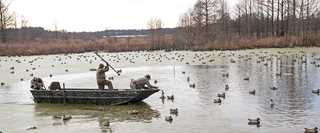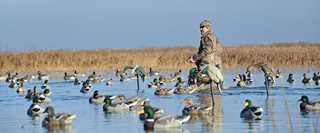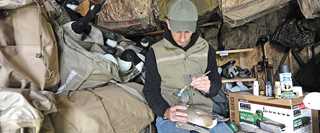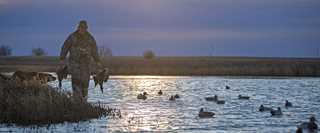Ten Ways to Improve Your Decoys
Follow this expert advice to set a more effective spread this season
Follow this expert advice to set a more effective spread this season
By David Hart
Decoys are an essential part of any waterfowl hunt. Whether you hunt Canada geese in corn, mallards in flooded timber, divers on big water, or woodies on a beaver pond, you need decoys to pull birds into range. But there's more to setting an effective spread than simply tossing out a few dozen decoys at random. The most successful hunters pay attention to every detail, including the appearance of each decoy and where it is placed. Following are 10 tips from decoy manufacturers and other avid waterfowlers on how you can increase the drawing power of your spread and bag more birds this fall.
In areas where ducks and geese are numerous, the birds often associate safety with numbers. That's why Cory Foskett, president of Tanglefree, uses large numbers of decoys during the first few weeks of the waterfowl season in California's Central Valley. In late October and early November, ducks often congregate in huge concentrations on flooded rice fields and managed wetlands. As the season progresses, those massive groups gradually break up, so Foskett decreases the size of his spread accordingly.
"We'll start with 500 to 1,000 decoys and pull out a few dozen every time we hunt," he says. "The key is to imitate what you see. If you are seeing big groups of waterfowl in the areas that you hunt, put out lots of decoys."
Going big isn't just an early-season tactic. Setting out hundreds of decoys can be the ticket in January too, as Foskett learned on a goose hunt in Kansas last season. While hunting Canada geese in an open hole in a partially frozen pond, he and his hunting partners packed five dozen floaters in the open water, eight dozen sleeper shells on the surrounding ice, and about 200 full-body decoys on dry land around the pond.
"The geese were used to seeing lots of birds in that area, so we set a spread that matched that behavior," Foskett says.

Large numbers of decoys can be highly effective in areas where waterfowl gather en masse.
Photo UPCLOSEPHOTO.COM
On key migration and wintering areas, a wide variety of ducks and geese regularly share the same habitats. Foskett replicates this natural diversity by including decoys of various species in his spread. "I like to use pintail and shoveler decoys because they have bright-white chests. They stand out, but they are also what you would expect to see mixed in with mallards in the places that I hunt," he says.
While ducks and geese will intermingle with other species of waterfowl, they usually spend more time with their own kind, especially when they are feeding or performing courtship activities. Consequently, Foskett sets his decoys in groups of the same species instead of mixing them together.
Hunters might argue about the importance of small details in the design of their decoys, but what matters most to Higdon Decoys marketing director Kelley Powers is how the decoys are painted. Do they actually look like the real thing? Some decoys do. Others not so much.
Equally important is a decoy's finish. Flocking, a soft coating that is used on the head, tail, and body of decoys, may cost more, but it's a worthwhile expense. According to Powers, the benefits of flocking are most pronounced on dark surfaces, such as the black necks of Canada geese and the dark-green heads of drake mallards.
"Flocking absorbs light and reduces the sheen and reflection you see on a standard decoy," he says. "It's especially effective when it's sunny or there is a light mist. Flocking won't shine like plastic will."

Flocked decoys can add an extra degree of realism to your spread.
Photo JIM THOMPSON
You've probably heard it countless times, but it still holds true. Ducks and geese are rarely completely motionless. If you want to fool today's highly educated waterfowl, you need to include natural movement in your decoys.
"The only time I don't use some sort of motion decoy is when it's windy, and the decoys are already moving," says Derek Rambo, a sales executive with Rio Ammunition.
Rambo typically uses four motion decoys that tip up, swim, and splash water, and places them within relatively close range of his blind. "Ducks always seem to land close to the motion decoys, so it's a good idea to place them where you want to shoot," he advises.
Rambo is also a firm believer in using an old-school jerk string to create motion in his spread. "Batteries can die, which is why you should always keep a jerk string in your bag. It never runs out of juice and it weighs only a few ounces, making it the perfect choice for hunts that require a long walk," he says.
Today's decoys are more lifelike than ever, but they don't come cheap. Even the highest-quality decoys won't last more than a few seasons if you don't take care of them. "The easiest way to make your decoys last is to store and transport them in slotted bags," Rambo says. "Not only do slotted bags prevent decoys from rubbing and banging against each other, they stack well in boats, trailers, and garages, which saves space."
Regular cleaning and maintenance is also required to keep decoys looking their best. Rambo uses a soft-bristled brush, dish soap, and a garden hose to remove mud and debris from his plastic decoys. He also touches up the paint and repairs flocking as needed to get his spread ready for opening day.

Clean the mud off your decoys and touch up the paint to get your rig ready for opening day.
Photo JIM THOMPSON
Banded-Avery sales manager Travis Mueller learned many years ago that visibility is crucial to the effectiveness of a decoy spread. "The importance of being seen was hammered home to me on a public marsh 20 years ago," he recalls. "I was hunting over a spread of five dozen duck decoys when another group of hunters set up a few hundred yards away. They were hunting over a couple dozen Canada goose decoys and shot three limits of mallards before I took my first duck. I think the ducks came off the refuge and saw their decoys before they saw mine and came right to them."
Mueller has used Canada goose decoys for both ducks and geese ever since. "They aren't just large, they are also dark in color, which I believe shows up even better from a distance than white decoys," he says. "Why do you think the old-timers used black milk jugs?"
A great way to save time and effort when deploying large numbers of decoys is to Texas-rig them in shallow-water habitats. Texas rigs are nothing more than a line and a weight, which are attached to each decoy with a large snap swivel. The line is made of heavy monofilament and has loops on either end. The weight slides freely on the line. When it's time to pick up the decoys, simply grab the loop and clip it to a carabiner.
Simplifying your decoy rigging offers a number of other advantages, says Rig'Em Right owner Matthew Cagle. "Texas rigs allow you to move your spread quickly if the wind shifts or you want to reduce the size of your spread," he explains. "One guy can move a spread of several dozen decoys in no time. They also make storage and organization easier in the off-season."
Texas rigs work best in water depths of six feet or less. Cagle switches to standard decoy lines and weights in water from six to 12 feet deep. Anything deeper and he rigs his decoys on a longline.
"Instead of using a heavy weight and a 15-foot line on each decoy, I set my spread on lines up to 100 yards long with an anchor on each end. Each decoy clips onto the main line. It's a fast and efficient system, and it works very well in areas with current or rough water," Cagle says. "The only downside is that your decoys are set in a straight line. To give my spread a more realistic look, I add a few individually rigged decoys between the longline rigs to fill in the gaps."
Watch a flock of ducks or geese in their natural habitat, and you'll see birds in a variety of positions. Some will be resting, others will be feeding, and a few will be alert watching for danger. Powers believes that using decoys in a variety of postures will add an extra degree of realism to your spread.
"When I'm hunting geese, I like my spread to include decoys with a good mix of body positions, including feeders, resters, and sentries," Powers says. "The posture of a goose says a lot about its attitude. If the majority of your decoys are feeders, you're telling incoming geese that there is plenty of food and that the birds on the ground are relaxed."
Powers places sentries in small groups on the periphery of the spread to imitate birds that have just landed and are checking things out. That can put real geese at ease. "Too many sentries scattered throughout the spread can appear like a bunch of nervous birds, which can be a red flag to geese," he says.
Sleepers and resters send a more confident message, but Powers prefers to use them later in the day. "It's not realistic for a goose to sleep first thing in the morning when the birds are actively feeding, but they will rest in the middle of the day in fields and around water. I especially like resting decoys on loafing ponds and on ice, but again, I like to use them later in the morning or in the afternoon after the geese feed," he says.
Heavily pressured waterfowl have seen it all. That's why veteran waterfowlers like Cagle go against the grain to give their spread a different look. "I don't use a spinning-wing decoy in areas with a lot of hunting pressure. I believe ducks have learned to associate them with danger, so they avoid them," he says. "I also like to place a dozen full-body decoys on the shoreline around my blind. Very few other hunters use them in my area, and they look great."
Powers switches to a smaller spread of magnum decoys when other hunters are using large spreads of standard blocks. He also mixes in black ducks with his mallard decoys. "The dark color of those decoys just stands out better, and that can help catch the attention of working ducks that are accustomed to seeing the same spreads in the area," he adds.

Setting your spread strategically can help bring birds in close for good shots.
Photo PHIL KAHNKE
The main purpose of any decoy spread is to bring birds in close enough to shoot. With few exceptions, ducks and geese land into the wind. Use that to your advantage by placing most of your decoys slightly upwind of where you want the birds to land. It's also important to create an open hole in the center of your spread to give decoying birds plenty of room to make their final approach.
"One of the biggest mistakes hunters make when setting decoys is not providing a clear landing zone for incoming birds. This is particularly important when it's windy. Ducks and geese have a harder time navigating in the wind, so it's a good idea to expand the landing zone in your spread on windy days," Mueller says.
Another common mistake is placing decoys too far from the blind. "There's no such thing as too close in my book," Mueller says. "Make sure the entire spread is close enough that the outside edge is in good range. There are always a few birds that want to land 10 yards past the last decoy. For me, it's all about getting close shots."
Ducks Unlimited uses cookies to enhance your browsing experience, optimize site functionality, analyze traffic, and deliver personalized advertising through third parties. By continuing to use this site, you agree to our use of cookies. View Privacy Policy